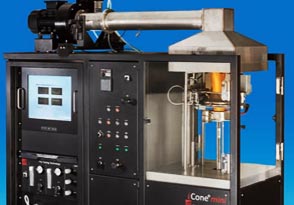This autumn, a new calorimeter arrives at DBI's fire lab. It will be used for small scale trials of materials before testing in full scale. And it can mean substantial savings for manufacturers.
It is not a big test DBI's new cone calorimeter performs. Actually, it is rather small. But the result, however, may prove to be of great importance.
- With the new calorimeter we can examine the fire properties of a small scale material - i.e. 10x10 cm of a product. And on the basis of data on ignition time and heat and smoke development, as the test gives, it is possible for some parameters to calculate the result of a full scale test, which gives access to the market, explains Martin Pauner, Civil engineer at DBI's fire testing department.
The small test does not accurately show how a larger construction of the material will behave in a full scale test, but the calculations give the manufacturer an idea of how the product will respond.
"So far, we have used just one calculation system to predict large scale test results, but we intend to add additional calculation models or further develop new ones so that we can calculate a variety of properties and achieve greater precision of the materials we are testing," says Martin Pauner.
Lower costs of product
The Cone Calorimeter or ISO 5660-1, as it is called, is not, as such, part of the classification system for construction products, but provides a lot of knowledge about the product, and gives the manufacturers greater understanding of their product.
- The manufacturer can use this knowledge to ensure that the fire classification he is looking for is in the product is meet. In this way he does not have the expenses of producing higher fire safety than necessary, says Martin Pauner, and stresses, that the cone calorimeter does not give all the answers about a product but merely gives an indication of how the product may perform in a full scale test.
However, this indication may be worth a lot of money for the manufacturer who does not have to finance a full scale test, if the small scale test of the product does not meet the planned fire classification. The new cone calorimeter is also considerably faster than previous solutions in the field, which means that manufacturers can expect a faster and more streamlined process when buying tests with the cone calorimeter.
"At the same time, we hope that, in time, we also can measure the toxicity of the smoke in the same test, so that the customer can learn even more with just one test," says Martin Pauner.
Useful for research
The usefulness of the Cone Calorimeter includes more than screening tests for construction materials. For several products the cone calorimeter is included as a central test in the EN 45545-2 train standard. And in IMO, the method is used for furniture and components for high-speed crafts. Furthermore, nations such as Australia and Japan use the cone calorimeter in their classification system for construction materials, which, however, are markets that DBI currently is not on.
"It will also be a powerful tool for our own research and development projects. We can use the large amount of data concerning fire properties of materials from the cone calorimeter when we develop new mathematical models and formulas to simulate fire properties of a product, says Martin Pauner.

